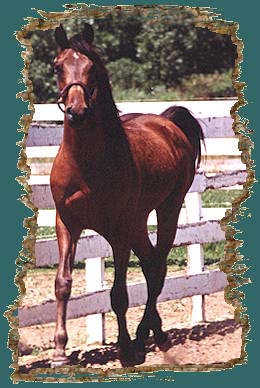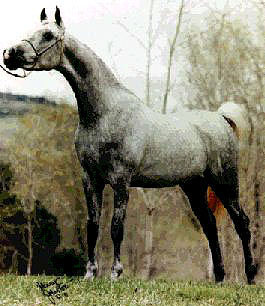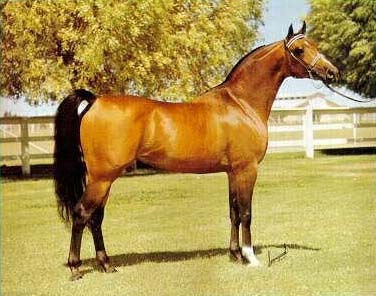
|
The Arabian
| ||

In 1873, during a trip to the Middle East, General Grant was presented two purebred Arabian Stallions, LEOPARD and LINDENTREE, by the Sulton, Abdul Hamid II, of Turkey. LEOPARD was later given to Randolph Huntington, who subsequently imported two mares and two stallions in 1888 from England. This program, limited as it was, must be considered the first purebred Arabian breeding program in the United States.
The second important influence upon the Arabian horse in America was the Turkish exhibition of 45 Arabian horses at the 1893 Chicago World's Fair. Among the imported Arabians shown were the mare, NEJDME and the stallion, OBEYRAN. These two horses subsequently became foundation animals No. 1 and No. 2 in the Arabian Horse Stud Book of America.
The third greatest influence in the development of the Arabian Horse Registry came from the Homer Davenport importation of Arabian horses in 1906.
According to Albert Harris' book on the history of the Registry: "This expedition was a remarkable one in many respects. It was sponsored by our President, 'Teddy' Roosevelt, financed by Peter B. Bradley, and executed by Homer Davenport, all three outstanding horsemen, and it resulted in the importation of the largest number of authentic Arabian horses in one shipment ever made to this country. It was in 1906 that Mr. Davenport, accompanied by Charles Arthur Moore, Jr., and John Henry Thompson, Jr., had the exciting and strenuous experience which he tells about in his book, 'My Quest of the Arabian Horse.' Twenty-seven splendid horses were secured in Arabia and transported safely to Boston."
Harris went on to write: "Davenport's importation of Arabian horses directly from the desert so aroused the enthusiasm of the few Arab breeders in this country that they decided to form a club and registry of their own to promote the interest of their horses and to offer encouragement for importation of new blood to America. The only place Arabian horses could be registered at the time was in the Jockey Club, and the interests of the Jockey Club lay solely in promoting the Thoroughbred."
On September 2, 1908, the Arabian Horse Club of America, Inc. was founded in New York state. The first meeting was held at the Hotel Belmont and was attended by the incorporators: Henry K. Bush-Brown, Homer Davenport, Charles A. Voetsch, Francis A. Huck, and James B. Kilburn.
The name and location of the organization changed two more times until it finally settled in Colorado under the name, "Arabian Horse Registry of America, Inc."

Under The Foal Coat: Clues for Getting
the Right Color:
The Registry records the following coat colors: bay, chestnut, grey, black, and roan (see color
examples). Most Arabians are registered as foals between the ages of three and six months.
Sometimes, this makes it difficult to correctly specify coat color on the registration application
because foals are usually born chestnut or dull bay and change colors after losing their foal
coats.
There are clues, however, to help owners determine what color a foal will be. Here are a few helpful hnts:
Markings: True and Faint
The Registry defines markings as configurations of solid white hairs contrasting with the surrounding coat color. "True" white markings grow from pink skin. Markings which grow from dark skin are described as "faint" markings. This distinction is particularly important on grey horses which grow lighter in coat color as they age, often disguising white markings. Pink skin is a permanent identifying mark.
Facial Markings::
Star-any white marking occurring above the eye line.
Strip-any white marking occurring below the eye line and above the top of the nostrils but within the nasal bones.
Snip-any white marking occurring between the top of the nostrils and the bottom of the nostrils.
Upper lip-any white marking occurring below the nostrils, but still on the upper lip.
Lower lip and chin-any white marking occurring on the lower lip and/or chin.
Leg Markings
Chestnuts are a copper color, varying in shades from a light golden-red to a dark brown, known as "liver chestnut."
Occasionally, a chestnut will have a "flaxen," or blonde, mane and tail. Sometimes, the mane and tail will be a mixture of blonde and chestnut hairs or brown and chestnut hairs. Quite often, the mane and tail will be the same color as the body coat.
Chestnut foals often have light blonde baby hair on their legs. This hair should not be confused with true white markings. If you aren't sure, wet down the hair and look for pink skin.
The rule of genetics to follow is that the mating of two chestnuts always results in a chestnut foal.
Bay:
Bay horses come in a variety of reddish-brown hues, and are distinguished by black points (mane, tail, legs, ears, knees, hocks, or any combination thereof). If there are white markings on the legs, there will usually be black above the markings.
Light bay horses may seem to resemble chestnuts in some cases, but the distinguishing difference will be the presence of black points.
During the greying process, a horse may show varying shades of grey. Some may appear steel grey, a mixture of black and white hairs. Others may be rose grey, a mixture of chestnut and white hairs, or bay grey, a mixture of bay and white hairs. Dappling is common. As grey horses age, their coat colors lighten, sometimes appearing to be white. Oftentimes, older grey horses grow tufts of reddish brown hair. This coloring is called "flea-bitten." All of these combinations are registered "grey."
The entire coat, including the muzzle, flanks, and legs, must be black with the exception of white markings. If any doubt arises between black and dark bay, black can be determined by noting the fine black hair on the muzzle.
Occasionally, an Arabian will be registered as a roan. A roan is defined for registration purposes as a horse with about a fifty-fifty mixture of white hairs with either chestnut, bay, or black hairs throughout the body. In the Arabian breed, the mixture is usually white and chestnut, creating the "strawberry roan."
It may be difficult to tell the difference between a rose grey and a roan at first. Roans show their permanent coat color after shedding their foal coats. Unlike greys, they do not dapple nor do they progressively lighten in color. Most roans will have a dark head, while grey foals will first turn light on the head.



